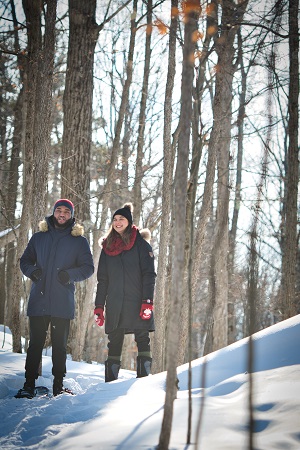If you’re reading this, you’re likely a human being with a core body temperature around 37ºC.
Your body works very hard to maintain this temperature. If it drops even a few degrees, moving, thinking, and other basic tasks become difficult. You will need to warm up quickly, or you may find yourself in a dangerous situation.
To prevent cold-related emergencies, it’s important to plan your winter adventures with care.
Our friends at Subaru Canada want to share the best ways to stay safe in cold weather:
1. Stay dry
Getting wet increases the rate at which your body loses heat.
Wear waterproof boots and mittens, and always stay off of ice that may not hold your weight.
Even shallow water can get your feet wet and drop your body temperature. Don’t risk it!
2. Dress in layers
Skiing, snowshoeing, and skating are exercise, and your body will generate heat.
If it generates too much heat, you begin to sweat. While this is great in hot weather, sweat is your enemy in the cold.
Remember the first rule: stay dry. Damp skin loses heat quickly. Remove clothing layers as you warm up to prevent that damp sweaty feeling and losing too much body heat.
Clothing next to your skin should be breathable and made of polypropylene or silk. This is your base layer.
Next is your mid layer, which is usually something like a warm sweater. Wool is the perfect mid layer material because it will stay warm even if it does accidentally get wet.
Finally, complete your outfit with a shell layer that keeps wind and water out but heat in.
Layers aren’t just for your torso. Long johns and snow pants do wonders for your lower body. Glove liners under mittens will keep your fingers warmer than mittens alone.
And as you take layers off, make sure to keep them handy. If you stop moving, you’ll need to snuggle back into that sweater or jacket!
3. Accessorize
A warm hat will go a long way towards keeping you toasty, and mittens will keep your fingers warmer than gloves.

Don’t neglect your feet! Boots with felt liners are a good idea.
Bringing extras also can’t hurt. Hat, mitten, socks, and boot liner replacements will be important if your things get wet.
Packed snow and icy conditions can make trails slippery. Watch the weather forecast for freezing rain, and bring along a pair of ice cleats or crampons to slip over your boots in case you need extra grip.
4. Watch the windchill
Cold temperatures are one thing, but cold windy conditions are another.
Wind speeds up the rate that your skin loses heat, so you can’t always trust the thermometer alone.
Before heading out the door, check the local weather forecast so you can be as prepared as possible. Lower windchills mean that warmer layers are necessary.
5. Bring water and snacks
Your body will burn more calories in cold weather. Fuel it with calorie-dense foods like trail mix — a classic for a reason!
It’s also important to stay hydrated. Winter air can be very dry, so keep a water bottle handy. Avoid caffeine and alcohol.
6. Know your limits
Pace yourself when doing physical activity, especially if you’re learning.
If it’s your first excursion of the season, start out with a shorter trek, or choose the smaller hill. Getting lost or injured could keep you outdoors longer than you would like to be.
7. Know the signs of an emergency
If someone is shivering, take steps to warm them as quickly as possible.
If you see any of the following symptoms in yourself or someone else, call 911 immediately:
- muddled thinking or having trouble paying attention
- slow, shallow breathing
- a weak pulse
- loss of consciousness
These are signs of hypothermia.
If you must wait for help to arrive, move to a warm area if possible. Seek shelter from the wind.
Prevent further heat loss by adding clothing layers or replacing wet items with dry ones.
Fingers, ears, and toes are at particular risk for frostbite. If any of these body parts are pale and waxy-looking, medical attention is necessary.
In the meantime, add clothing layers and move to a warm area. Do not rub the area.
Bring on the snow!
Outdoor activity is important in winter for both mental and physical health.

Enjoy the benefits of being outdoors and reduce the risk by keeping dry, wearing layers, and watching the weather forecast. Tackle activities within your limits, eat enough calories, and bring extra water. And never be afraid to call for emergency help if you need it.
Enjoy Ontario’s specialty season: winter!
Ontario Parks thanks corporate partners  like Subaru Canada for their support.
like Subaru Canada for their support.





